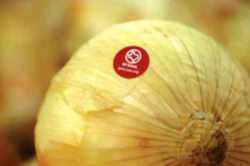
Texas Symbols
Texas State Vegetable
Sweet Onion

(Allium genus)
Adopted on May 5, 1997.
On May 5, 1997, Governor George W. Bush signed House Concurrent Resolution No. 148 making the Texas sweet onion to official state vegetable of Texas.
A sweet onion is a variety of onion that is not pungent. Their mildness is attributable to their low sulfur content and high water content when compared to other onion varieties.
Originating around Iran, onions have been cultivated for 7,000 years and have played an important part in history. Onions came to the New World with Spanish Explorers - the perfect compliment to our native corn, peppers, and tomatoes. The famed sweet onions of Texas began in 1898 with a packet of Bermuda onion seed planted near Cotulla in South Texas.
Texas State Vegetable: Sweet Onion

The onion is a member of the pungent Allium genus of the lily family, which also includes garlic, leeks, shallots, and scallions. The word onion comes to us from the Latin unio (meaning large pearl), which in Middle English became unyon. Most commercially-grown are of the common or seed (A. cepa) variety.
The onion was considered as valuable as gold in the Middle Ages and has long been a symbol of eternity due to their structural composition of layers
within layers forming a sphere. The onion has amazingly been the focus of some mighty strange legislation over the years. For example, in Nacogdoches,
Texas, it's against the law for "young women" to indulge in any raw onions after 6 pm!
Sweet onion varieties have been traced back to a packet of seeds from the Canary Islands shipped to South Texas in 1898. Those Bermuda onion seeds
were planted near the city of Cotulla. The sweet onion crop was an instant success. The onions were shipped in 1899 to Milwaukee, Wisconsin, where
they were so enthusiastically received that a larger acreage was planted.
By 1904, approximately 500 acres of Bermuda onions were planted in South Texas. In spring, 1907, 1,011 carloads of onions were shipped from South and
Southwest Texas; in 1908, production had more than doubled, and in 1909, 12 counties shipped 2,920 carloads. Shipments reached 6,735 carloads in 1917;
this figure was not exceeded until 1928 and 1929 when the total movements were 7,055 and 7,232 carloads, respectively. The largest movement in 50 years
for a single season was 10,164 carloads in 1946.
In 1933, the Texas Agricultural Experiment Station began a cooperative breeding program with the U. S. Department of Agriculture to develop new
hybrids and varieties.
The Canary Islands, principally Teneriffe Island, produced most of the onion seed planted in Texas until about 1946. The two types of Bermuda onions
generally grown in Texas were the Yellow Bermuda and White Bermuda and Crystal Wax.
Texas 1015s, the Lone Star State's most famous onions, taste sweet. They don't make you cry either because they contain very little of a substance called pyruvate, which is released during chopping, causing tears. According to the onion's developer, Dr. Leonard Pike, of the Texas A&M Vegetable Improvement Center, 1015s mild taste makes them perfect for salads and sandwiches.
ONIONS are Texas' leading vegetable crop. Onion sales bring the state between $70 and $100 million per year and the onion industry has an overall impact of about $350 million per year on the Texas economy. Most of the sweet yellow onions, which people all over the world enjoy because you can "eat them like an apple", can trace their origin to the Lone Star state.
What does the "1015" mean?
That's the best date to plant it, October 15.
Texas House Concurrent Resolution No 148
Texas HOUSE CONCURRENT RESOLUTION
By Wise H.C.R. No. 148
WHEREAS, The State of Texas has traditionally recognized a variety of official state symbols as tangible representations of the proud spirit and heritage
of our state; and
WHEREAS, The bluebonnet, pecan tree, and the mockingbird are examples of natural specimens that serve to exemplify the great diversity of the Texas
landscape, while the state fruit, Red Grapefruit, fittingly represents another aspect of our shared culture as Texans; and
WHEREAS, In Keeping with the custom, the designation of the Texas Sweet Onion as the official state Vegetable of Texas will provide suitable recognition
for this outstanding food resource; and
WHEREAS, First discovered and enjoyed by the earliest inhabitants of Texas this variety of onion has been carefully nutured and perfected over time
and is renowned for its sweetness and flavor; and
WHEREAS, The 1015 Onion is recognized by gourmet chefs and culinary experts and sought after around the world for its sweetness and its inherent properties
which inhibits the tearing of the eyes while retaining its nutritious and health benefits; and
WHEREAS, The Lone Star State's reputation as a global leader in the development of various varietals of vegetables is well deserved, and the development
of the 1015 Onion as the first sweet onion in the world has contributed greatly to this proud legacy; and
WHEREAS, As distinctive as the proud state from which it originates, the Texas Sweet Onion will serve as a fitting emblem for the bounties of nature
with which our state is blessed; now, therefore, be it
RESOLVED, That the 75th Legislature of the State of Texas hereby designate the Texas Sweet Onion as the official State Vegetable of Texas.
House Concurrent Resolution No. 148, 75th Legislature, Regular Session (1997)
Texas Law
The Texas sweet onion was named the official vegetable of the State of Texas by House Concurrent Resolution and is not, therefore, listed in the Texas Statutes.

List Official US State Foods






